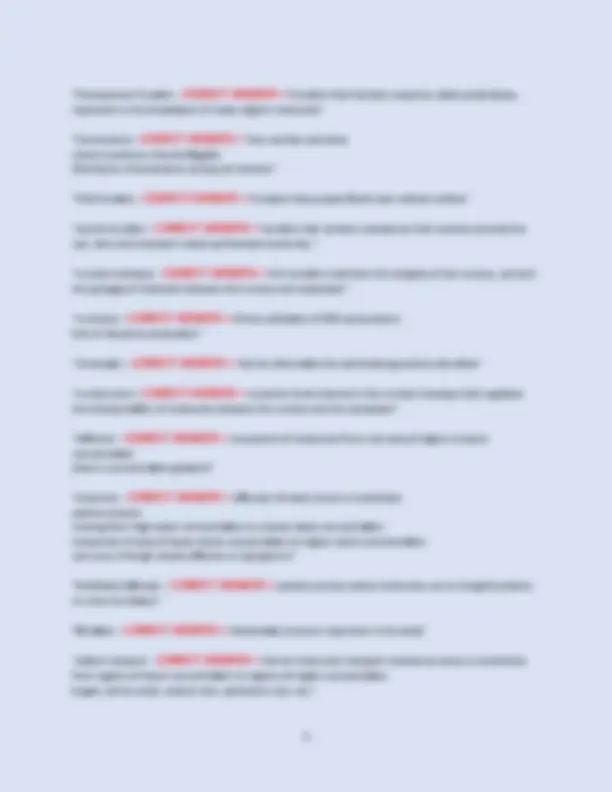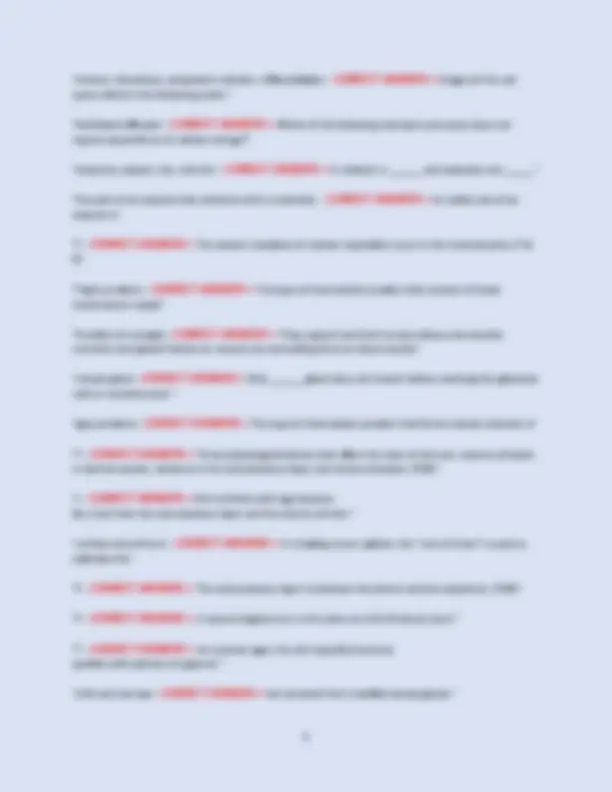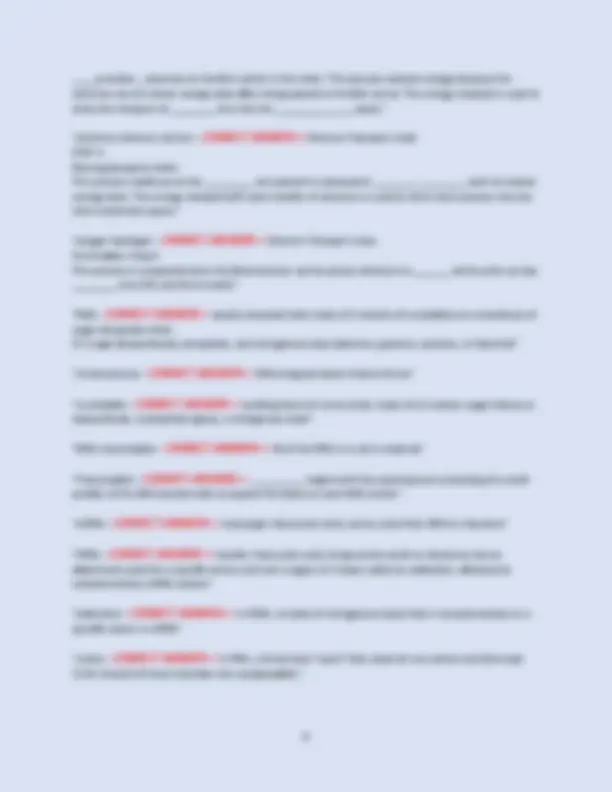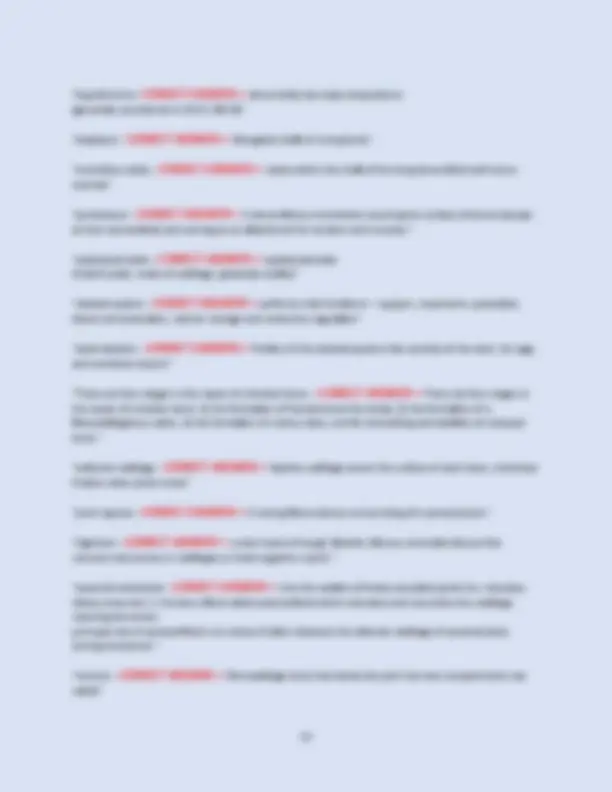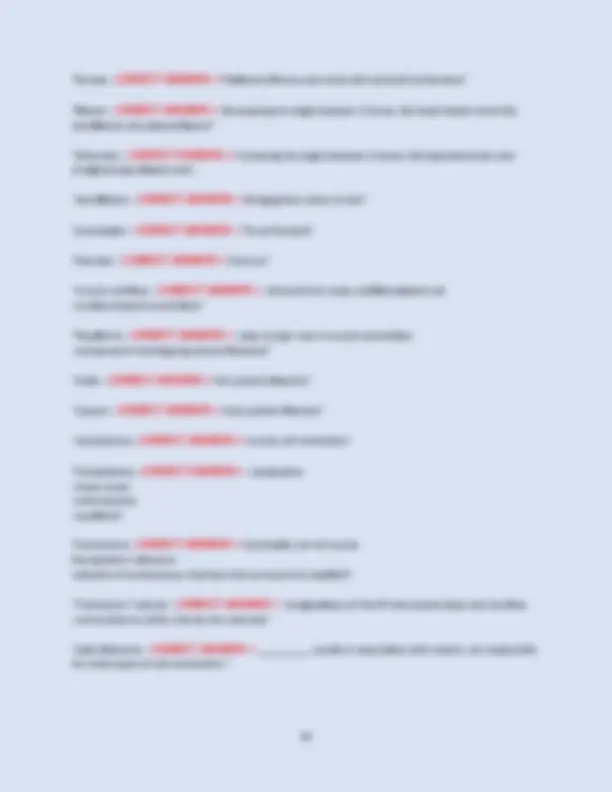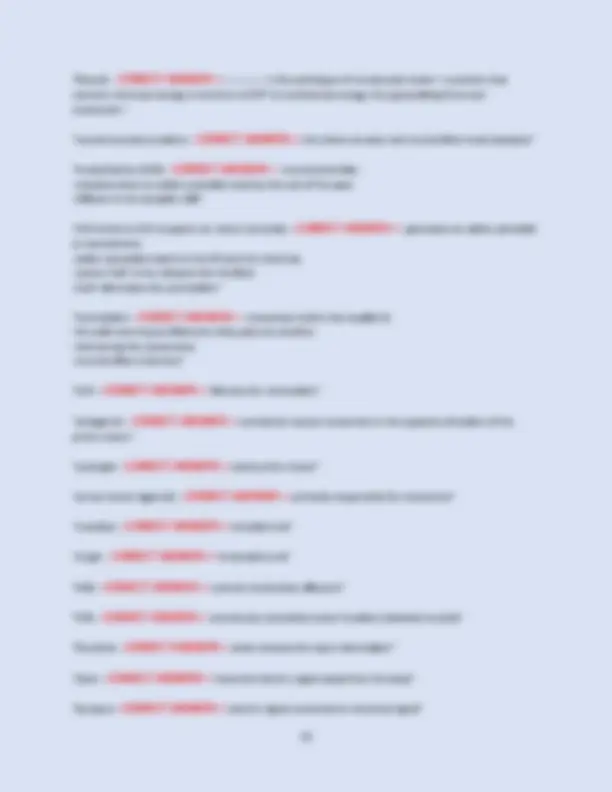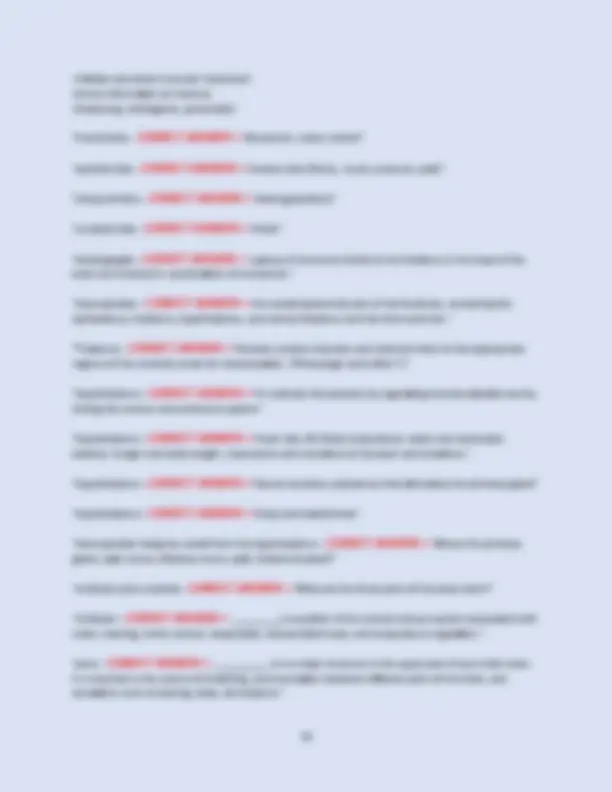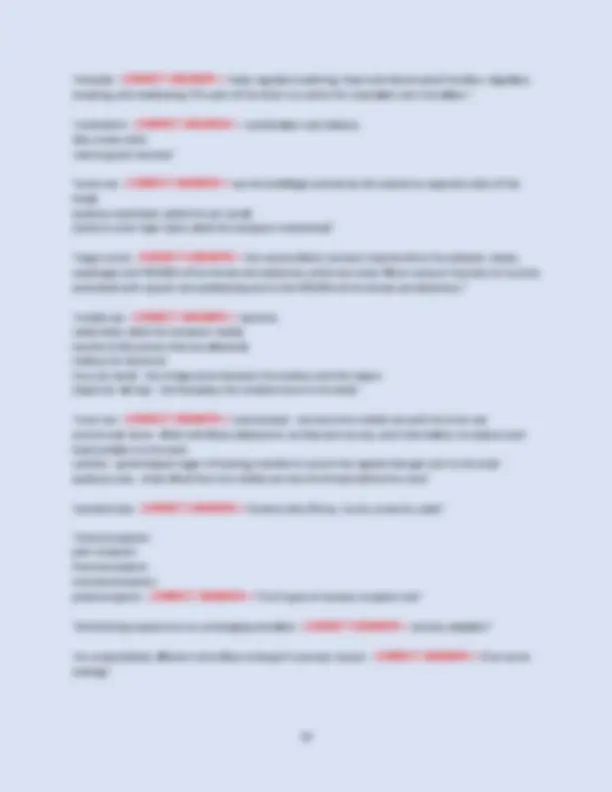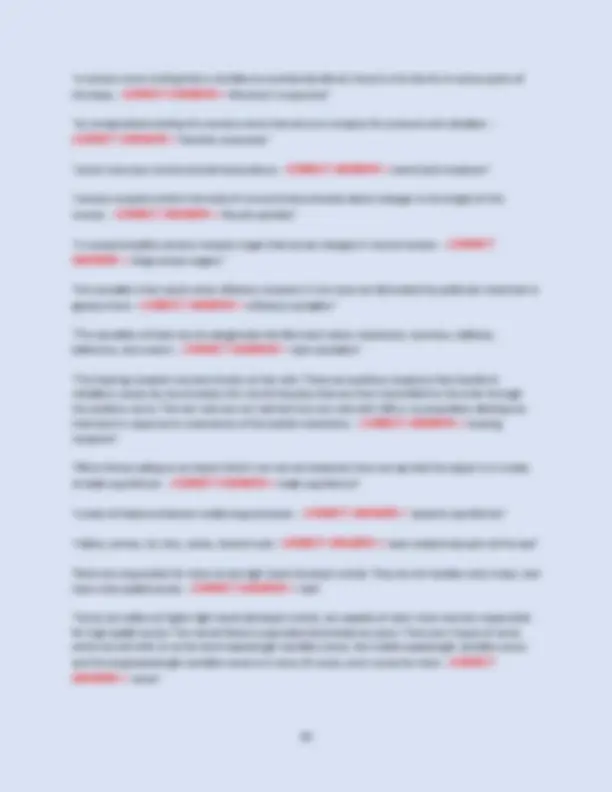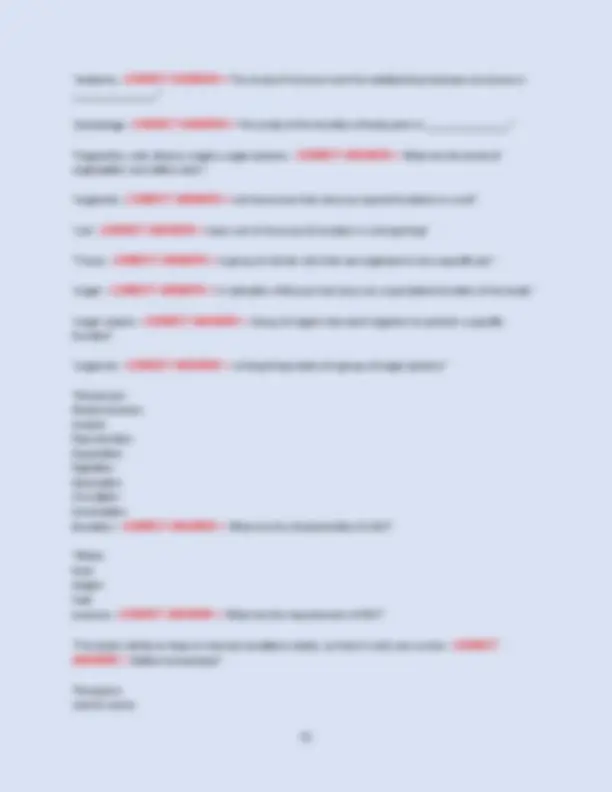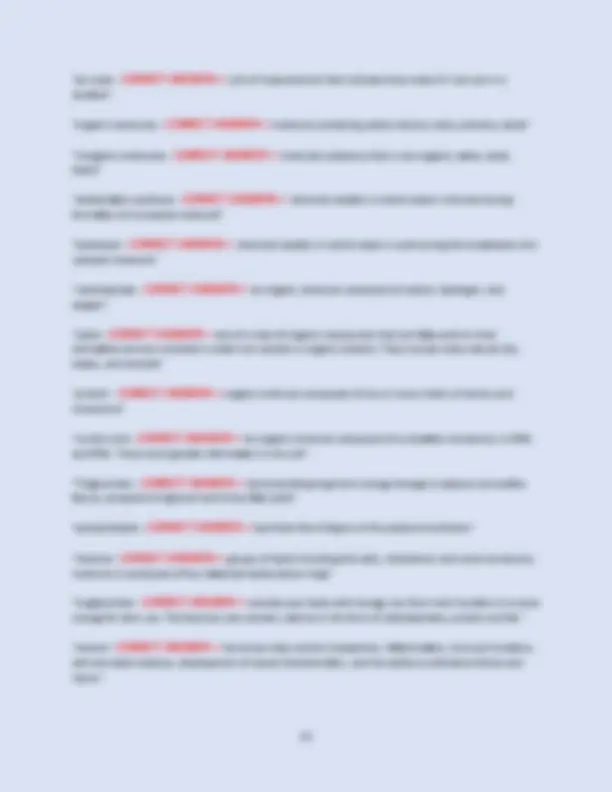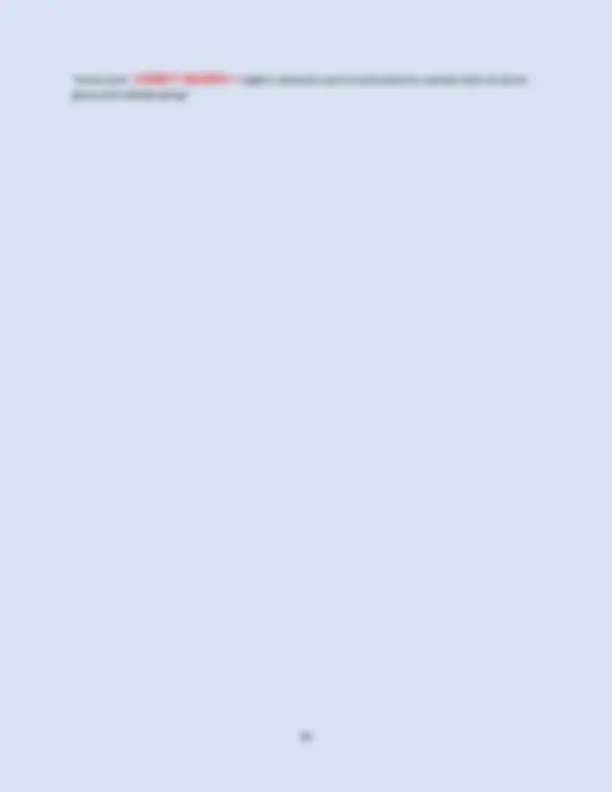Download APHY 101 FINAL EXAM LATEST MOST TESTED 300 QUESTIONS AND CORRECT ANSWERS IVY TECH and more Exams Biology in PDF only on Docsity!
APHY 101 FINAL EXAM LATEST MOST
TESTED 300 QUESTIONS AND CORRECT
ANSWERS IVY TECH COMMUNITY
COLLEGE INDIANAPOLIS WITH VERIFIED
DETAILED SOLUTIONS 2025/2026.
"enzymes - CORRECT ANSWER=> Many of these types of reactions (synthesis, decomposition,
exchange, and reversible) need what to speed up the reaction with lower amounts of energy"
"dna - CORRECT ANSWER=> deoxyribose with an additional OH"
"rna - CORRECT ANSWER=> ribose"
"DNA - CORRECT ANSWER=> appears as a Double Helix. It appears like a twisted ladder. Within the
structures are rungs represented by Four-letter alphabet. The spiral is also made up of sugar and phosphate"
"RNA - CORRECT ANSWER=> a spiraling thread with bases sticking out towards the center. It also
consists of sugar, phosphates and nitrogenous bases"
"DNA - CORRECT ANSWER=> • A (Adenine)
- G (Guanine)
- C (Cytosine)
- T (Thymine)"
"RNA - CORRECT ANSWER=> • A (Adenine)
- G (Guanine)
- C (Cytosine)
- U (Uracil)"
"Thymine - CORRECT ANSWER=> Adenine pairs with (DNA)"
"Guanine - CORRECT ANSWER=> Cytosine pairs with"
"Urecile - CORRECT ANSWER=> Adenine pairs with (RNA)"
"DNA - CORRECT ANSWER=> • Replication of genetic information
- Transfer of genetic information"
"RNA - CORRECT ANSWER=> • Carry genetic information"
"DNA - CORRECT ANSWER=> • Cell Nucleus and Mitochondria"
"RNA - CORRECT ANSWER=> • Cell Nucleus, Cytoplasm and Ribosome"
"Cell membrane - CORRECT ANSWER=> Controls what moves in and out of the cell,Selectively
permeable, outer limit of a cell"
"endoplasm - CORRECT ANSWER=> fluid part of the cytoplasm"
"cytosol - CORRECT ANSWER=> liquid surrounded by cell membrane"
"organelles - CORRECT ANSWER=> solids surrounded by cell membrane"
"cell membrane - CORRECT ANSWER=> controls the passage of materials into and out of the cell, and
provides for signal transduction"
"protein, lipid, cholesterol, - CORRECT ANSWER=> Cell Membrane Structure
Membrane mainly composed of"
"ribosome - CORRECT ANSWER=> Free floating or connected to ER
Provide structural support and enzyme activity to amino acids to form protein"
"smooth ER - CORRECT ANSWER=> Lipid synthesis
Added to proteins arriving from rough ER Break down of drugs"
"golgi apparatus - CORRECT ANSWER=> this function packages and modifies protein molecules for
transport and secretion."
"mitochondria - CORRECT ANSWER=> Membranous sacs with inner partitions
Generate energy"
"lysosome function - CORRECT ANSWER=> Contain enzymes capable of digesting worn cellular parts or
substances that enter cells (function)"
"endocytosis - CORRECT ANSWER=> Cell engulfs a substance by forming a vesicle around the
substance Three types: Pinocytosis, Phagocytosis, Receptor-mediated"
"phagocytosis - CORRECT ANSWER=> process by which a cell takes in a solid substance"
"pinocytosis - CORRECT ANSWER=> liquid and small particles dissolved in liquid"
"exocytosis - CORRECT ANSWER=> exit out of the cell
vesicles fuse with plasma membrane as secretion occurs membrane of vesicle becomes part of the plasma membrane vesicles are targeted by their destinations by SNARE proteins"
"transcytosis - CORRECT ANSWER=> Endocytosis followed by exocytosis
Transports a substance rapidly through a cell HIV crossing a cell layer"
"passive transport - CORRECT ANSWER=> simple diffusion, facilitated diffusion, filtration and osmosis."
"isotonic - CORRECT ANSWER=> no gain or loss of water
no change in cell shape"
"hypotonic - CORRECT ANSWER=> solution has a lower solute concentration than inside of the cell
water enters the cell (Bursts)"
"hypertonic - CORRECT ANSWER=> solution has a higher solute concentration than inside the cell
water leaves the cell (Shrivels)" "Both move a substance from a region of higher concentration to one of lower concentration without
cellular energy. - CORRECT ANSWER=> What characteristic do simple diffusion and facilitated diffusion
share"
"hypertonic - CORRECT ANSWER=> Cells lose water when placed in a __________ solution."
"Basic - CORRECT ANSWER=> A water solution that contains equal numbers of hydrogen ions and
hydroxide ions is"
"hydrogen bonds - CORRECT ANSWER=> The secondary structure of a protein molecule is the result
of"
"Carbon Hydrogen - CORRECT ANSWER=> An organic compound always contains"
"mitosis, interphase, cytoplasmic division, differentiation - CORRECT ANSWER=> Stages of the cell
cycle unfold in the following order:"
"facilitated diffusion - CORRECT ANSWER=> Which of the following transport processes does not
require expenditure of cellular energy?"
"enzymes; copper, iron, and zinc - CORRECT ANSWER=> A cofactor is ______ and examples are _____."
"the part of an enzyme that combines with a substrate. - CORRECT ANSWER=> An active site of an
enzyme is"
"T - CORRECT ANSWER=> The aerobic reactions of cellular respiration occur in the mitochondria. (T &
F)"
"Tight junctions - CORRECT ANSWER=> The type of intercellular junction that consists of fused
membranes is a(an)"
"function of nureglia - CORRECT ANSWER=> They support and bind nervous tissue and provide
nutrients and growth factors to neurons by connecting them to blood vessels"
"simple gland - CORRECT ANSWER=> (An) ______ gland does not branch before reaching the glandular
cells or secretory part."
"gap junctions - CORRECT ANSWER=> The type of intercellular junction that forms tubular channels is"
"T - CORRECT ANSWER=> Three physiological factors that affect the color of skin are: volume of blood
in dermal vessels, carotene in the subcutaneous layer, and various diseases. (T&F)"
"t - CORRECT ANSWER=> Skin wrinkles with age because
fat is lost from the subcutaneous layer and the dermis shrinks."
"surface area of burn - CORRECT ANSWER=> In treating a burn patient, the "rule of nines" is used to
estimate the"
"F - CORRECT ANSWER=> The subcutaneous layer is between the dermis and the epidermis. (T&F)"
"F - CORRECT ANSWER=> A second degree burn is the same as a full-thickness burn."
"T - CORRECT ANSWER=> As a person ages, the skin typically becomes
spotted with patches of pigment."
"milk and ear wax - CORRECT ANSWER=> are secreted from modified sweat glands."
"aerobic reactions - CORRECT ANSWER=> occur when oxygen is available; pyruvic acid is used to
produce acetyl CoA; citric acid cycle begins; electron transport chain functions; carbon dioxide and water are formed; up to 36 molecules of ATP are produced per each glucose molecule"
"aerobic respiration stages - CORRECT ANSWER=> Krebs Cycle/AKA citric acid cycle, and electron
transport chain/ AKA oxidative phosphorylation via chemiosmosis These are both aerobic and exclusively aerobic"
"glycolysis - CORRECT ANSWER=> can proceed under aerobic and anaerobic conditions."
"anaerobic respiration - CORRECT ANSWER=> makes a total of 2 ATP"
"Aerobic respiration - CORRECT ANSWER=> makes up to 38 ATP"
"6 6 30 - CORRECT ANSWER=> What is produced besides Atp? In aerobic respiration: __ molecules of
carbon dioxide, __ molecules of water, and up to __ molecules of ATP (adenosine triphosphate), which is directly used to produce energy, from each molecule of glucose in the presence of surplus oxygen."
"aerobic - CORRECT ANSWER=> what type of respiration happens in the mitrocondria"
"glycolysis - CORRECT ANSWER=> converting one 6 carbon molecule of glucose into two 3 carbon
molecules, occurs in cytoplasm"
"glycolysis - CORRECT ANSWER=> series of 10 reactions occurring in the cytosol; anaerobic phase of
cellular respiration that breaks down glucose into 2 pyruvic acid molecules; yields 2 ATP molecules per glucose molecule"
"anaerobic - CORRECT ANSWER=> occur when oxygen isn't available; electron transport system can't
accept new electrons; pyruvic acid is converted to lactic acid; glycolysis is inhibited; ATP production is less"
"anaerobic - CORRECT ANSWER=> takes place in the fluid portion of the cytoplasm"
"electron transport chain - CORRECT ANSWER=> a series of electron carriers embedded in the cristae
of the inner mitochondrial membrane."
"reduced oxidized - CORRECT ANSWER=> Electron Transport chain
STEP 1:
The electron carriers shift between _______ and ________ states as they accept and donate electron"
"NADH 2 hydrogen inter-membrane - CORRECT ANSWER=> Electron Transport chain
____ provides _ electrons to the first carrier in the chain. This process releases energy because the electrons are at a lower energy state after being passed to the first carrier. The energy released is used to drive the transport of ________ ions into the ______________ space."
"electrons electron carriers - CORRECT ANSWER=> Electron Transport chain
STEP 3:
Moving along the chain: This process continues as the _________ are passed to subsequent ________ ________, each at a lower energy state. The energy released with each transfer of electrons is used to drive more protons into the inter-membrane space."
"oxygen hydrogen - CORRECT ANSWER=> Electron Transport chain
Termination: Step 4 This process is completed when the final electron carrier passes electrons to ______, which picks up two ________ ions (H+) and forms water"
"DNA - CORRECT ANSWER=> double stranded helix made of 2 strands of nucleotides on a backbone of
sugar phosphate chain 5 - C sugar (deoxyribose), phosphate, and nitrogenous base (adenine, guanine, cytosine, or thymine)"
"chromosomes - CORRECT ANSWER=> DNA wrapped about histone forms"
"nucleiotide - CORRECT ANSWER=> building block of nuclei acids; made of a 5-carbon sugar (ribose or
deoxyribose), a phosphate group, a nitrogenous base"
"DNA transcription - CORRECT ANSWER=> All of the RNA in a cell is made by"
"Transcription - CORRECT ANSWER=> __________ begins with the opening and unwinding of a small
portion of the DNA double helix to expose the bases on each DNA strand."
"mRNA - CORRECT ANSWER=> messenger ribonucleic acid; carries code from DNA to ribosome"
"tRNA - CORRECT ANSWER=> transfer ribonucleic acid; brings amino acids to ribosome; has an
attachment paint for a specific amino acid and a region of 3 bases called an anticodon, attracted to complementary mRNA codons"
"anticodon - CORRECT ANSWER=> in tRNA, a triplet of nitrogenous bases that is complementary to a
specific codon in mRNA"
"codon - CORRECT ANSWER=> in RNA, a three-base "word" that codes for one amino acid (Concept
11.4). Several of these translate into a polypeptide."
- cells are tightly packed"
"to cell shape and number of cell layers - CORRECT ANSWER=> Epithelial tissues are classified
according"
"Epithelial tissue layers - CORRECT ANSWER=> - simple (one layer of cells)
- stratified (more than one layer of cells)"
"Glandular epithelium - CORRECT ANSWER=> compose of cells that are specialized to produce and
secrete substances"
"Connective tissue fibers - CORRECT ANSWER=> - collagenous fibers
- reticular fibers
- elastic fibers" "-loose connective tissue
- dense connective tissue - CORRECT ANSWER=> Connective tissue types"
"Connective tissue - CORRECT ANSWER=> - varying degrees of vascularity
- cells that usually divide"
"Connective tissue - CORRECT ANSWER=> - bind structures
- provide support and protection
- serve as frameworks
- fill space
- store fat
- produce blood cells
- protect against infections
- help repair tissue damage"
"connective tissue - CORRECT ANSWER=> extracellular matrix."
"dense connective tissue - CORRECT ANSWER=> - dense regular
"Dense irregular connective tissues - CORRECT ANSWER=> - randomly organized, thick, interwoven
collagenous fibers
- dermis of skin
- around skeletal muscles"
"Dense regular connective tissue - CORRECT ANSWER=> - closely packed collagenous fibers
(elastic fibers, fibroblasts)
- very strong
- binds body parts together
- tendons, ligament, dermis
- poor blood supply, slow to heal"
"Loose connective tissue - CORRECT ANSWER=> - areolar
"Cartilage - CORRECT ANSWER=> - rigid matrix containing gel-like ground substance
- chodrocytes in lacunae
- poor blood supply
- covered by perichondrium"
"Bone - CORRECT ANSWER=> - solid matrix
- supports
- protects
- forms blood cells
- attachment for muscles
- skeleton
- osteocytes in lacunae"
"Cartilage - CORRECT ANSWER=> Chondrocytes"
"Lacunae - CORRECT ANSWER=> Small chambers that contain chondrocytes; found in the extracellular
matrix"
"Bone cell - CORRECT ANSWER=> Osteocyte"
"Lamellae - CORRECT ANSWER=> a thin layer, membrane, scale, or platelike tissue or part, especially in
bone tissue"
"Canaliculi - CORRECT ANSWER=> small channel or duct in bone"
"muscle tissue - CORRECT ANSWER=> Contractile; skeletal, smooth, and cardiac"
"skeletal muscle tissue - CORRECT ANSWER=> - Attached to bones
"smooth muscle tissue - CORRECT ANSWER=> - Walls of organs
- Skin
- Walls of blood vessels
"hypothermia - CORRECT ANSWER=> abnormally low body temperature
(generally considered to 35.0 C (95.F))"
"diaphysis - CORRECT ANSWER=> Elongated shaft of a long bone"
"medullary cavity - CORRECT ANSWER=> cavity within the shaft of the long bones filled with bone
marrow"
"periosteum - CORRECT ANSWER=> A dense fibrous membrane covering the surface of bones (except
at their extremities) and serving as an attachment for tendons and muscles."
"epiphyseal plate - CORRECT ANSWER=> epiphyseal plate
Growth plate, made of cartilage, gradually ossifies"
"skeletal system - CORRECT ANSWER=> performs vital functions— support, movement, protection,
blood cell production, calcium storage and endocrine regulation"
"axial skeleton - CORRECT ANSWER=> Portion of the skeletal system that consists of the skull, rib cage,
and vertebral column"
"There are four stages in the repair of a broken bone: - CORRECT ANSWER=> There are four stages in
the repair of a broken bone: 1) the formation of hematoma at the break, 2) the formation of a fibrocartilaginous callus, 3) the formation of a bony callus, and 4) remodeling and addition of compact bone."
"articular cartilage - CORRECT ANSWER=> Hyaline cartilage covers the surface of each bone, minimizes
friction when joints move"
"joint capsule - CORRECT ANSWER=> A strong fibrous tissue surrounding of a synovial joint."
"ligament - CORRECT ANSWER=> a short band of tough, flexible, fibrous connective tissue that
connects two bones or cartilages or holds together a joint."
"synovial membrane - CORRECT ANSWER=> Line the cavities of freely moveable joints (i.e. shoulder,
elbow, knee etc). 2. Secrete a fluid called synovial fluid which lubricates and nourishes the cartilage covering the bones. principal role of synovial fluid is to reduce friction between the articular cartilage of synovial joints during movement."
"menisci - CORRECT ANSWER=> Fibrocartilage discs that divide the joint into two compartments are
called"
"Bursae - CORRECT ANSWER=> Flattened, fibrous sacs lined with synovial membranes"
"flexion - CORRECT ANSWER=> Decreasing the angle between 2 bones. Ex) head toward chest like
dorsiflexion and plantar flexion"
"Extension - CORRECT ANSWER=> Increasing the angle between 2 bones. Ex) hyperextension and
straightening a flexed neck"
"dorsiflexion - CORRECT ANSWER=> Bringing foot closer to shin"
"protraction - CORRECT ANSWER=> Thrust forward"
"Eversion - CORRECT ANSWER=> Sole out"
"muscle cell fiber - CORRECT ANSWER=> - formed from many undifferentiated cell
- multinucleated muscle fiber"
"Myofibrils - CORRECT ANSWER=> - play a major role in muscle contraction
- composed of overlapping protein filaments"
"Actin - CORRECT ANSWER=> thin protein filament"
"myosin - CORRECT ANSWER=> thick protein filament"
"sarcolemma - CORRECT ANSWER=> muscle cell membrane"
"Sarcoplasma - CORRECT ANSWER=> - cytoplasma
- many nuclei
- mitochondria
- myofibrils"
"Sarcromere - CORRECT ANSWER=> Contractile unit of muscle.
Sarcoplasmic reticulum network of membranous channels that surround the myofibril"
"Transverse T tublues - CORRECT ANSWER=> - invaginations of the SR that extend deep into the fiber
- surrounded on either side by the cisternae"
"actin filaments - CORRECT ANSWER=> _________, usually in association with myosin, are responsible
for many types of cell movements."
"Nerve cells - CORRECT ANSWER=> _________ are functionally classified as sensory neurons, motor
neurons, or interneurons."
"Sensory neurons - CORRECT ANSWER=> __________ (afferent neurons) are unipolar, bipolar, or
multipolar shaped cells that conduct action potentials toward or into the central nervous system."
"Ciliated ependymal cells - CORRECT ANSWER=> move cerebrous spinal fluid around to keep it
homogenous"
"astrocytes - CORRECT ANSWER=> form the blood brain barrier"
"microglia - CORRECT ANSWER=> they do phagocytosis to fight infection"
"oligodendrocytes - CORRECT ANSWER=> bind the CNS neurons together and insulate the axons"
"non ciliated ependymal cells - CORRECT ANSWER=> secrete cerebro spinal fluid"
"schwann cells - CORRECT ANSWER=> insulate PNS axons"
"polarization - CORRECT ANSWER=> is the resting state of the myocardial wall when there is not
electrical activity in the heart and is recorded on the ECG strip as a flatline , repolarization repolarization is the process of reaching the resting state before they can electrically simulated again"
"repolarization - CORRECT ANSWER=> is the process of reaching the resting state before they can
electrically simulated again"
"Action Potential - CORRECT ANSWER=> rapid sequence of depolarization and repolarization"
"action potential - CORRECT ANSWER=> when threshold is reached; basis for nerve impulse"
"all or none response - CORRECT ANSWER=> Define nerve impulse; when a stimulus of threshold
intensity or above is applied to an axon, all impulses carried on that axon are of the same strength"
"Saltatory conduction - CORRECT ANSWER=> The process by which if insulating myelin is present on an
axon then the nerve impulses that is conducted will "jump" from gap to gap in the myelin layer. Salta in spanish= jump."
"neurotransmitters - CORRECT ANSWER=> diffuses across synaptic cleft and reacts with specific
receptors on postsynaptic neuron membrane"
"synaptic vesicles - CORRECT ANSWER=> found in synaptic knobs; releases neurotransmitters;
receptor- a region of tissue, or a molecule in a cell membrane, that responds specifically to a particular neurotransmitter, hormone, antigen, or other substance."
"synaptic cleft - CORRECT ANSWER=> gap that separates two neurons at a synapse"
"meninges - CORRECT ANSWER=> surrounds brain and spinal cord"
"pia arachnoid dura matter - CORRECT ANSWER=> name layers of meninges from inside out"
"ventricles - CORRECT ANSWER=> - filled with CSF
- Continuous with central canal"
"spinal cord - CORRECT ANSWER=> The center for spinal reflexes; conduit for impulses to and from the
brain."
"sensory and motor - CORRECT ANSWER=> 4. Explain a simple reflex. A simple reflex is an automatic
response to a stimulus. Both humans and animals usesimple reflexes to escape from danger, What functional neurons are involved?"
"ascending tracts - CORRECT ANSWER=> Carry sensory impulses up the cord.
- Faciculus gracilis
- Fasiculus cuneatus
- Spinothalamic Tracts
- Spinocerebellar Tracts"
"descending tracts - CORRECT ANSWER=> Carry nerve impulses away from the brain.
- Corticospinal tracts
- Reticulospinal Tract
- Rubrospinal Tracts"
"cerebral cortex - CORRECT ANSWER=> The ______ _______ is divided into four sections, called "lobes
a fissure (Latin fissura, plural fissurae) is a groove, natural division, deep furrow, elongated cleft, or tear in various parts of the body also generally called a sulcus, or in the brain a sulcus."
"a fissure - CORRECT ANSWER=> is a groove, natural division, deep furrow, elongated cleft, or tear in
various parts of the body also generally called a sulcus, or in the brain a sulcus."
"sulci - CORRECT ANSWER=> The sulci (or fissures) are the grooves"
"gyri - CORRECT ANSWER=> gyri are the "bumps" that can be seen on the surface of the brain"
"functions of the cerebrum - CORRECT ANSWER=> - Interprets impulses from sense organs
"medulla - CORRECT ANSWER=> helps regulate breathing, heart and blood vessel function, digestion,
sneezing, and swallowing. This part of the brain is a center for respiration and circulation."
"cerebellum - CORRECT ANSWER=> - coordination and balance
- fine motor skills
- learning and memory"
"outer ear - CORRECT ANSWER=> auricle (cartilage covered by skin placed on opposite sides of the
head) auditory canal (also called the ear canal) eardrum outer layer (also called the tympanic membrane)"
"vagus nerve - CORRECT ANSWER=> the sensory fibers conduct impulses form the pharynx, larynx,
esophagus and VISCERA of the thorax and abdomen; while the motor fibers conduct impulses to muscles associated with speech and swallowing and to the VISCERA of the thorax and abdomen:"
"middle ear - CORRECT ANSWER=> eardrum
cavity (also called the tympanic cavity) ossicles (3 tiny bones that are attached) malleus (or hammer) incus (or anvil) - the bridge bone between the malleus and the stapes stapes (or stirrup) - the footplate; the smallest bone in the body"
"inner ear - CORRECT ANSWER=> oval window - connects the middle ear with the inner ear
semicircular ducts - filled with fluid; attached to cochlea and nerves; send information on balance and head position to the brain cochlea - spiral-shaped organ of hearing; transforms sound into signals that get sent to the brain auditory tube - drains fluid from the middle ear into the throat behind the nose"
"parietal lobe - CORRECT ANSWER=> Sensory lobe (Temp., touch, pressure, pain)"
"chemoreceptors pain receptors thermoreceptors mechanoreceptors
photoreceptors - CORRECT ANSWER=> The 5 types of sensory receptors are"
"diminishing response to an unchanging sensation - CORRECT ANSWER=> sensory adaption"
"an unspecialized, afferent nerve fiber ending of a sensory neuron - CORRECT ANSWER=> Free nerve
endings"
"a sensory nerve ending that is sensitive to mechanical stimuli, found in the dermis in various parts of
the body. - CORRECT ANSWER=> Meissner's corpuscles"
"an encapsulated ending of a sensory nerve that acts as a receptor for pressure and vibration. -
CORRECT ANSWER=> Pacinian corpuscles"
"sense innocuous environmental temperature - CORRECT ANSWER=> warm/cold receptors"
"sensory receptors within the belly of a muscle that primarily detect changes in the length of this
muscle. - CORRECT ANSWER=> Muscle spindles"
"is a proprioceptive sensory receptor organ that senses changes in muscle tension. - CORRECT
ANSWER=> Golgi tendon organs"
"the sensation that results when olfactory receptors in the nose are stimulated by particular chemicals in
gaseous form - CORRECT ANSWER=> olfactory sensation"
"The sensation of taste can be categorized into five basic tastes: sweetness, sourness, saltiness,
bitterness, and umami. - CORRECT ANSWER=> taste sensation"
"The hearing receptors are also known as hair cells. These are auditory receptors that transform vibrations causes by sound waves into neural impulses that are then transmitted to the brain through the auditory nerve. The hair cells are not real hairs but are cells with 100 or so projections sticking out
that bend in response to movements of the basilar membrane. - CORRECT ANSWER=> hearing
receptors" "When forces acting on an object which is at rest are balanced, then we say that the object is in a state
of static equilibrium. - CORRECT ANSWER=> static equilibrium"
"a state of balance between continuing processes. - CORRECT ANSWER=> dynamic equilibrium"
"retina, cornea, iris, lens, sclera, choroid coat - CORRECT ANSWER=> basic anatomical parts of the eye"
"Rods are responsible for vision at low light levels (scotopic vision). They do not mediate color vision, and
have a low spatial acuity. - CORRECT ANSWER=> rods"
"Cones are active at higher light levels (photopic vision), are capable of color vision and are responsible for high spatial acuity. The central fovea is populated exclusively by cones. There are 3 types of cones which we will refer to as the short-wavelength sensitive cones, the middle-wavelength sensitive cones
and the long-wavelength sensitive cones or S-cone, M-cones, and L-cones for short - CORRECT
ANSWER=> cones"

